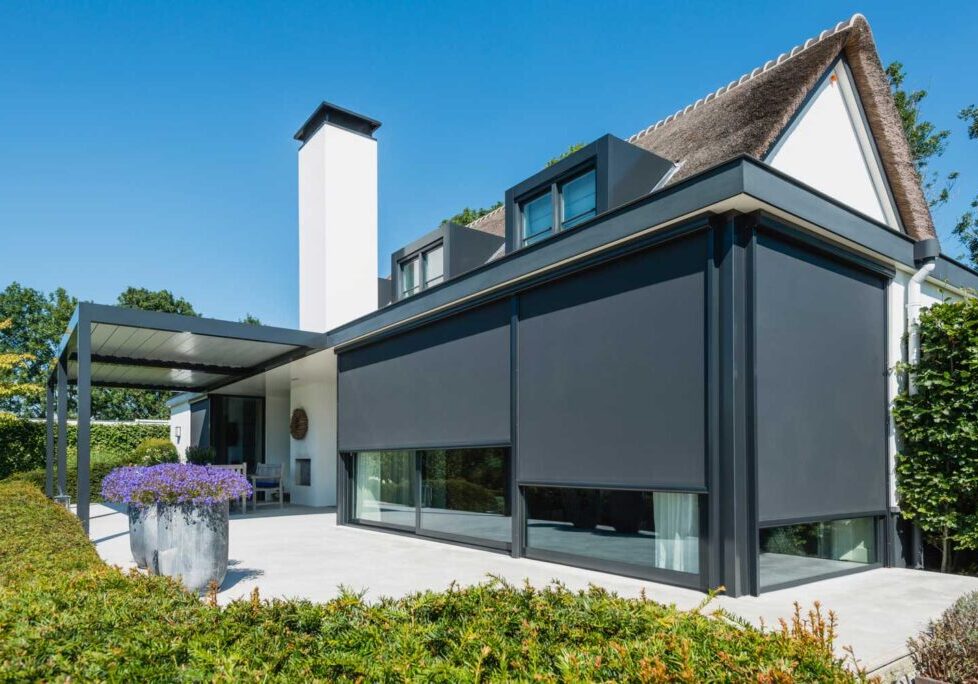Are Exterior Blinds Necessary For Triple Glazed Windows?

As the UK moves closer to its Net Zero commitments, homes are being designed to be better insulated, more airtight, and far more energy efficient than ever before. With the Future Homes Standard due in Autumn 2025, these changes are about to accelerate.
One key measure already confirmed is that all new homes must now include solar panels, projected to save households around £350 a year on energy bills. Alongside this, we can expect stronger requirements for low-carbon heating, insulation, and high-performance glazing—especially triple glazing.
But as we reduce heat loss, we must also be careful not to trap too much heat inside. With the UK experiencing longer, hotter summers and more frequent heatwaves, the risk of overheating is a real and growing challenge.
Why Triple Glazing Isn't the Whole Story
Triple glazing is excellent at preventing heat loss. Modern triple-glazed units often achieve U-values as low as 0.6–0.8 W/m²K, nearly twice as efficient as typical double glazing (1.1–1.3 W/m²K). This thermal performance helps cut heating bills and improve year-round comfort.
But U-value is only part of the picture.
The G-value - which measures how much solar energy passes through the glass - is lower for triple glazing too, typically around 0.4 - 0.5 compared to 0.6 - 0.7 for double glazing. That means around 40 - 50% of solar heat still enters the building, even with triple glazing.
In cooler months, this can be a benefit. But in spring and summer, especially on south- or west-facing facades or in buildings with large windows and limited ventilation, that solar gain can lead to excessive indoor temperatures.
And triple glazing - by being so good at holding heat in - can make it harder for buildings to cool down once they’ve warmed up.
Hotter Summers Are Already Here
The Met Office recorded the warmest spring on record in 2025, with UK average temperatures 1.8°C above normal. It was also the sunniest ever recorded in Northern Ireland, Scotland, and Wales, and the second sunniest in England.
Climate change isn’t a future problem - it’s already changing how we design and live in buildings. Homes and offices that perform well in winter may quickly become uncomfortable during heatwaves if we don’t take solar control seriously.
External Blinds - A Smart, Passive Cooling Solution
One of the most effective ways to reduce solar heat gain is through external shading. External blinds - especially those made from high-performance, heat-reflective fabrics - can reduce indoor temperatures by several degrees as soon as they’re deployed.
While internal blinds may help with glare, they don’t stop the sun’s energy from entering the building. By contrast, external blinds intercept solar radiation before it hits the glass, preventing heat buildup at the source.
External blinds can block up to 90% of solar gain
They reduce reliance on air conditioning or mechanical cooling
They support Part O compliance for new homes and residential buildings
In winter, they provide an extra barrier against heat loss
They’re fully controllable via smartphone or building automation systems
For buildings with triple glazing, this external control layer becomes even more important. High-performance glazing reduces heat transfer, but without solar shading, heat that enters can remain trapped—especially in airtight, well-insulated homes such as those built to Passivhaus standards.
A Sustainable Alternative to Air Conditioning
Air conditioning currently accounts for around 3% of global greenhouse gas emissions, and that figure is expected to rise sharply. For individual households, the cost of running A/C can double energy bills - especially during prolonged hot spells.
That’s why passive solutions like external blinds are gaining traction. They use minimal energy to operate and are far more sustainable than mechanical cooling systems.
For example, at Kensington Blinds, we’ve worked on numerous retrofit and new-build projects where installing external blinds not only brought down peak indoor temperatures but also improved user comfort, reduced glare, and lowered reliance on active cooling.
Balancing Light & Comfort
Architects, designers, and homeowners choose external blinds for their attractive, sleek look, flexibility, and effectiveness.
And you don’t need to worry about not being able to see out through the blinds.
They are made with heat-reflecting fabric with a special weave that allows you to see the view outside while letting natural light into the room.
When is Triple Glazing Enough - and When Are External Blinds Essential?
While triple glazing significantly improves insulation and reduces unwanted heat loss, it isn’t a silver bullet when it comes to solar gain and summertime overheating. Whether you need to add external blinds depends on several key factors:
Triple Glazing May Be Sufficient When:
Windows face north or east, receiving limited direct sun
Window-to-wall ratios are low or moderate
Rooms are designed with good natural cross-ventilation
The home is in a cooler or more shaded location
The occupant's tolerance for higher summer temperatures is reasonably high
In these situations, the lower g-values of triple glazing may be enough to limit solar gain to manageable levels - especially if passive cooling strategies are used elsewhere in the design.
External Blinds Are Recommended When:
Glazing faces south or west, where it’s exposed to the strongest sun in the afternoon and evening
Large expanses of glass are used, such as in open-plan living areas or feature windows
The building is highly insulated and airtight (e.g. Passivhaus), making it harder to shed heat
Ventilation is limited, such as in urban infill sites or bedrooms with only one small opening window
The building must comply with Part O, particularly in warmer climate zones or at-risk orientations
In these scenarios, even high-performance glazing can let in enough solar energy to raise internal temperatures well beyond comfort levels - especially during heatwaves, which are becoming more frequent in the UK climate.
Our recommendation: For most new homes with south- or west-facing windows, especially in open-plan layouts, external shading should be considered essential to maintain thermal comfort, meet regulatory standards, and reduce future cooling demand.
Need Advice on Your Blinds Project?
If you’re working on a new build or retrofit project and want to know more about integrating external blinds into your design, our expert team would be happy to help. Whether it’s improving comfort, achieving compliance with Part O, or reducing operational energy, we can provide tailored advice and support.



